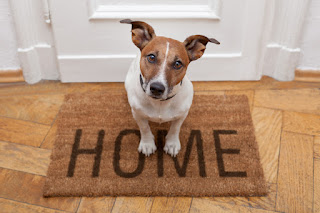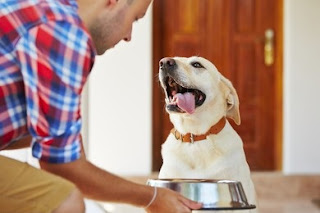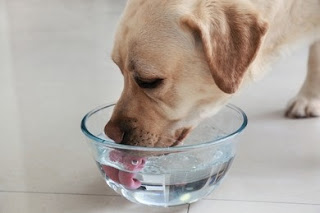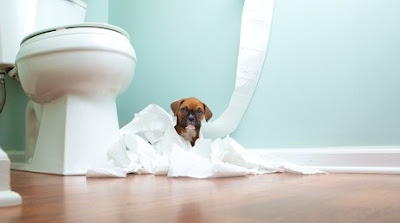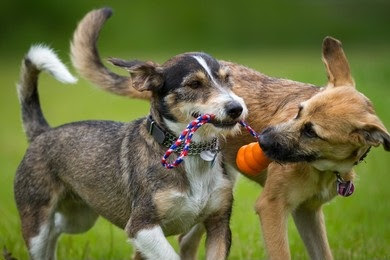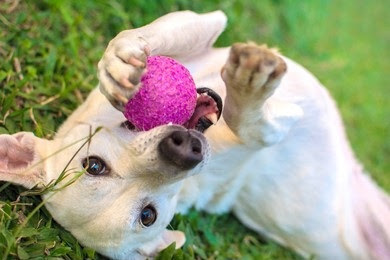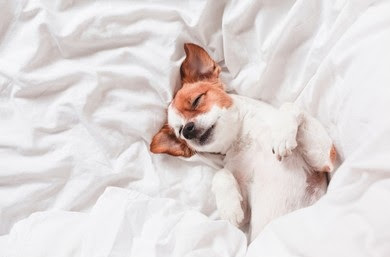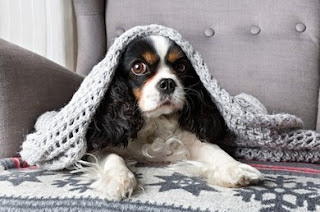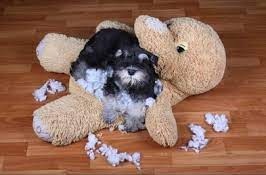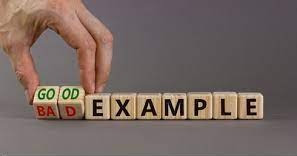How To Create A Puppy Care Schedule ? And Example
Whether it's doing our hair or going to the gym, our days are made up of daily recurring activities! These patterns make it easier for us to get through our days, and when they're disrupted (like not receiving your coffee before work, ouch!) it may throw us off completely. Puppies, like humans, thrive on routine and may readily adapt to our way of life. It's up to you to make one for them, and here's how to do it!
In the first few weeks of your new puppy's life, so lot happens: meeting the family, vaccines, beginning puppy training, and so on! Setting up a regular regimen for your dog is something you may have ignored without realising it. "I walk my dog every morning and feed him in the afternoon!" you may be thinking. They stick to a schedule." Do you feed your puppy at regular intervals? Do you have any scheduled playtime or walks with them on a daily basis? If you answered no to at least one of those questions, you still have work to do to create a timetable.Setting up a routine doesn't mean planning every detail of your dog's day for the rest of their life, but it does require ensuring that key things like toilet breaks and feedings are done on a regular basis.
Why Do Puppies Need Schedules?
Let's start with why your dog requires a routine. When a small puppy first arrives at a new home, he or she is attempting to comprehend and adjust to their new surroundings and family. When it comes to toilet training, establishing appropriate eating habits, and encouraging their confidence and relationship with you, sticking to a plan is crucial. A regular schedule makes your puppy's environment more predictable, allowing them to relax more automatically as they anticipate what will happen next. Unpredictable toilet accidents, poor food habits, and even more unwanted behaviours such as increased barking or nipping might result from abnormalities in their routine.Because puppies have a shorter-term memory, repetition is crucial in helping them learn, which is something that a timetable provides. Step one is to create a routine that works for everyone in the household and start implementing it right away with your dog! Don't worry if you can't follow it perfectly every day or if some days are a little different. You're doing fine as long as you stick to the timetable as much as possible. Fortunately, puppies learn and adapt to routines rapidly, so take advantage of this.
The following should be on your puppy's daily schedule: potty time, free time, food/water time, nap time, repeat!
The sooner you establish a routine, the easier it will be for him to adjust to his new family and for you to adjust to him. Routine makes it easy for everyone, including humans, to understand what is and is not appropriate conduct. Keep in mind that the antics of a cute puppy, as well as small "accidents," will not be so cute when he's a full-grown dog. The example schedule provided below is a nice place to start; you may need to modify it to fit your puppy's needs.
You'll be well on your way to a happy, well-adjusted dog if you set the habit from the start. It's worth investing the time and effort now to ensure that bad habits and behaviours don't take hold.
Set the Rules of the House
Make sure everyone in your human family agrees on fundamental guidelines before it arrives home—or very soon after. If one person lets the puppy into the living room and another becomes furious when it leaves the linoleum floor region, the puppy will have no idea what is permitted and what is banned.
Puppies require constancy in order to learn. Changing the rules isn't fair to them or to you, and it prevents them from being the wonderful companion they were created to be. Consider the following:
- Is it okay for the dog to sit on the furniture?
- What will the puppy's sleeping quarters be? Do you keep your dog in a kennel, a crate, the kitchen, or your bed?
- Will the puppy ever be fed human food? If that's the case, what foods would you feed them and under what circumstances?
- What kinds of actions should the puppy be praised for?
There are several choices to be made, and it is up to you to make them. Pick your fights carefully. Sleeping together can help your kids bond faster, but if they're allergic, it's probably not a good idea. The trick is for everyone in the family to agree and then follow the rules consistently.
Food Time
Are you a morning person or do you work nights and get up later? In any case, time your puppy's meals to coincide with your own breakfast, lunch, and dinner. Because young pups feed three times a day, it's simple to establish this from the start. Inconsistent meal times, by nature, frequently imply inconsistent toilet times. Many pups need to go to the bathroom within 30 minutes of feeding, while others may go for longer if they snooze straight after or keep their activity moderate. Keeping note of when and how often your puppy has to go pee can allow you to spot patterns and anticipate when they will need to "go" next.Knowing this knowledge and keeping to the same mealtimes every day will help you avoid problems in the future when dealing with unexpected toilet accidents.
Water
Dogs want to have constant access to fresh, clean water. Ensure that your dog's bowl is clean. Replace the water and clean the bowl on a daily basis.
Potty Breaks
Taking your dog out to pee is another key practise to maintain. This is especially important for a young puppy's toilet training. Your puppy may need to eliminate more frequently at first as they learn when and where to go and become capable of keeping it longer as they mature. Young pups need to go out for toilet breaks regularly during the day (they can typically "hold it" longer overnight). As a general rule, split your puppy's age in months in half to calculate how long they may stay there. (For example, a three-month-old puppy should be taken out every 1.5 hours to relieve itself.)This is an excellent beginning point to incorporate into your daily routine that you can tweak as your puppy develops and is able to hold it for longer periods of time. If you work during the day, consider hiring a dog sitter or having a family member who can take your dog out for bathroom breaks to help you with this!
Keeping note of when your puppy goes potty can help you create a fantastic routine for how often they need to go out, which you can easily change as they grow and their potty breaks get longer!
Puppies need to go pee every 1–4 hours, depending on their age, with younger puppies needing to go more frequently.
Puppies should have consistent periods throughout the day set aside specifically for going outdoors to aid with toilet training. Remember to take your dog outdoors as soon as you let them out of the kennel!
A dog must be allowed outdoors to pee at the following five times during the day:
- Following a period of rest/sleep,
- Following the play sessions
- After you've eaten and drunk,
- In the crate or before retiring to bed
- Prior to and following training sessions
Also, don't be shocked if your puppy needs to go pee again soon after he's been outside. Puppies don't always excrete completely each time they go. If your dog didn't pee when you let him out because he was too busy chasing his friend or attempting to eat the leaves off your bush, he'll need to go as soon as you allow him inside (much to your displeasure, I'm sure). Just be patient and give him as many chances as possible to do it correctly.
Keywords Training
Although small pups are unable to enrol in official training classes right away, this does not preclude you from teaching him some fundamental skills on a daily basis. Keywords are something that every puppy may start learning. Start with key phrases like "good," "bad," and "no." Keep these words basic, and use the same ones every time. Your dog must become accustomed to hearing the same phrases again in order to link the same meanings with them.
Socialization and Learning Time
Socialization is arguably the most important thing a puppy needs to grow into a happy adult. Socialization is the most effective strategy to prevent future behaviour problems, yet it is something that many dog owners ignore (avoid this frequent error!).
Taking your dog to the dog park or to a few puppy courses isn't enough for canine socialising. Similarly, dog owners must make certain that they are not overstimulating their new puppy, since this will only lead to problems down the road. Socialization is a methodical process in which you introduce your puppy to the world around them gradually and attentively, always at their own speed and in a good and safe manner. It's also important to understand how your dog learns (surprise! They learn the same way you do!).
Every day should be filled with opportunities for socialisation, such as teaching them basic skills with positive reinforcement and enrolling them in puppy training classes, investigating the environment around them, visiting the veterinarian, going on leash walks, playing with other dogs and new people, and experiencing the sights and sounds of everyday life with you. The idea is to keep it brief and sweet.
Enrichment and Playtime
Puppies require time to engage with you and expend some of their puppy energy, as well as to have fun! Engaging your puppy in chew toy play is also a fantastic way to teach them proper play etiquette, such as not nibbling hands and feet. Having some planned playing throughout the day guarantees that you spend meaningful bonding time with your children.
Enriching your dog's life is vital to their healthy development. Puppies that don't get enough play and enrichment are more prone to develop anxiety, fear, and lack confidence, as well as be socially undeveloped and have behavioural issues in adolescence.
Schedule moments during the day when you can give your dog your entire attention. Before you go for work, spend some time with them playing with toys or performing some basic training; this will help them adjust to your absence. While you're gone, provide them some fun interactive toys or puzzles to keep them occupied. Go outdoors every day as soon as you get home and play tug or throw their favourite ball. Take them for a stroll after supper and show them about your area.
Playtime is an important part of your dog's life, but it should never be unduly long or strenuous. Think short and sweet: Despite appearances, your 3-month-old dog cannot withstand more than 15–20 minutes of considerable activity at any given time, or they may feel overarousal and overstimulation. Make sure your dog has a chance to relax undisturbed after any mental or physical activity (and a bathroom break!).
It's time to take a nap!
It may appear as if your new puppy never sleeps, but then all of a sudden, they'll seem to do nothing but sleep. Their sleep schedule changes as their bodies grow and adjust. Don't think your high-energy dog isn't in need of a snooze! Puppies that don't get enough rest are more prone to turn into grumpy little sharks (your hand will quickly learn this with each nip), so pay attention to their body language and stop playing before it gets too much.
Plan for calm moments when your dog may relax without being disturbed by other people in the house. Short naps in their crate or kennel on a regular basis are a terrific way to get crate training off to a good start, ensuring that it becomes a beloved secure zone as well.
When it comes to bedtimes, your dog may readily follow your example and go to sleep when you do. Just remember to let them go potty again immediately before you both turn in for the night.
It will take a few weeks or longer for your puppy to adjust to his new surroundings and feel at ease. The sooner you establish a plan and keep to it, the easier it will be for your dog to acclimate to his new life with you.
A young puppy may require as much as 20 hours of sleep every day! Their bodies are rapidly maturing, and they can easily become overtired after playing. Schedule a few nap periods during the day in a calm area of the house, then place your pet in their crate or playpen to sleep. If your puppy is overtired, he or she may get irritable (much like a child!) and act out by nipping or barking. That just indicates it's sleep time!
Having a peaceful environment for your puppy to rest in can assist them in settling down faster and getting the sleep they require during their naps.
Opportunities to Eliminate
Adult dogs prefer to urinate and defecate at least once every eight hours. Some dogs may require less. Even while some dogs can contain their pee for a long period, if given the option, they would prefer to "go out" every 6 to 8 hours. Puppies should be allowed out more frequently, especially if you're trying to housebreak them. See the House training schedules for further information.
General Comfort
Dogs want to be in a clean, comfortable environment that is neither too hot nor too chilly. The majority of dogs are content indoors, however some canines like living outside as well. During periods of excessive heat or cold, dogs prefer the warmth of the inside. If your dog is an outdoor dog, they should have access to a warm shelter in the winter and shade in the summer, as well as fresh, clean water at all times.
Time
Dogs like being pampered and spending time with their owners. They will feel valuable and appreciated during this time, much as we do when a loved one offers us their entire attention. This "time" might simply consist of sitting or watching television. Many dogs like it if you additionally pet or brush them!
Notes for Energetic Breeds' Owners
Because two 30-minute walks are unlikely to meet your dog's activity demands, which might lead to behaviour difficulties, you'll want to change the above programme to incorporate additional cardiovascular exercise.
At least an hour of cardiovascular activity, such as going to a dog park, playing fetch, or jogging beside you, should be scheduled. See the page on exercise for some workout suggestions.
Puppy That Hasn't Been Trained
If you have a puppy under the age of a year, you'll want to add the following to the above schedule:
2 to 3 months of age
- Increase the number of bathroom breaks to 6-8 per day - puppies should anticipate to hold their bladder for 1 hour for every month they are old. You should take them out every 2-3 hours at this age.
- Add 1-2 nighttime potty breaks - Yes, you'll have to get up in the middle of the night to take your puppy outdoors to relieve himself. Try not to feed or water your puppy within 3 hours of bedtime to help limit overnight potty breaks to one.
- Add 1-2 more feedings - Smaller bellies necessitate more frequent feedings.
4 to 5 months of age
- Add 3-4 extra bathroom breaks throughout the day - puppies should be able to hold their bladder for 1 hour per month of age. You should take them out every 4-5 hours at this age. This implies you'll need a restroom break or two in the middle of the day.
- Add 0–1 toilet breaks to your nighttime routine – you might be able to sleep through the night without needing to get up for a bathroom break. Feed or hydrate your puppy three hours before sleep to prevent nighttime potty trips. Before you try to make your puppy hold it for an entire 8 hours, see how long he can go without requiring a pee break in the middle of the night.
- Add 1-2 more feedings - Smaller bellies necessitate more frequent feedings.
6 to 7 months of age
- During the day, add 1-2 more toilet breaks - at this age, you should take them out every 6-7 hours. This implies you'll probably need a toilet break in the middle of the day.
- No more nocturnal potty breaks - Assuming you don't feed or water your pet within 3 hours of bedtime and don't sleep more than 8 hours, you should be able to remove the need for potty breaks in the middle of the night. However, because every dog is different, don't be surprised if yours still requires you to wake up after 5-6 hours to take him out.
- Set up a feeding schedule of 1-2 times per day - don't go from 4 to 1 feeding right away. All adjustments should be made gradually. Check out the feeding section of the article and talk to your vet about the best food schedule for your dog.
8 to 11 months of age
- Your dog should be able to go for at least 8 hours without having to go outdoors; however, you should not expect more than that, and a midday bathroom break is still welcomed.
- Try to offer him a midday toilet break; if you can't, he should be able to hold it. Again, each dog is unique, so don't be surprised if yours still needs a noon pee break.
- Eliminating nocturnal potty breaks gives you more confidence - Your dog should be able to sleep for at least 8 hours without needing to go outside. Again, feeding or hydrating him within 3 hours of night is not a smart idea.
- Set up a feeding schedule of 1-2 times per day - don't go from 4 to 1 feeding right once. All adjustments should be made gradually. Check out the feeding section of the article and talk to your vet about the best food schedule for your dog.
12 months and up
- You might be able to go 10 hours without a potty break at night - at this point, you should base your decision on your own observations of your dog's specific behaviour and needs.
- Set up a feeding schedule of 1-2 times per day - don't go from 4 to 1 feeding right once. All adjustments should be made gradually. Check out the feeding section of the article and talk to your vet about the best food schedule for your dog.
Example
Still having trouble putting out a daily plan that works for your puppy? We made a simple one that could be useful! Because this is only a sample, use it as a guide to help you figure out when to include particular activities for your dog that are appropriate for your lifestyle. Simply alter the time between bathroom breaks and the duration of exercise time as needed, based on your pup's age and how long they can hold it. The order in which the tasks are completed is more crucial than the times in which they are completed, in order to aid with toilet training and minimise accidents as much as possible.
Having a timetable you can pass over to a puppy sitter, an aiding family member, or even negotiate with a daycare will come in useful and keep your dog on track for new puppy owners who work throughout the day.
This is only some examples of an adult dog's everyday schedule. There are many ways to customise this for your personal lifestyle or to change it based on other obligations you may have, such as dinner reservations with friends or a trip to the grocery store.
The most essential thing is to keep your dog's potty and food schedules regular as much as possible.
First Example
Daily Schedule:
Morning:
7AM: Wake up
Potty
Activity :Walking
Breakfast + Water
Naptime
9AM: Potty
Activity : Playtime
Water
Naptime
Afternoon:
12PM: Potty
Activity : Training
Lunch + Water
Naptime
3PM: Potty
Activity : Playtime
Water
Naptime
Evening:
6PM: Potty
Activity :Walking
Dinner + Water
Naptime
9PM: Potty
Activity : Training
Water
Last potty of the night
Bedtime
Second Example
Morning
Take the puppy out first thing in the morning to relieve himself. After he's taken care of his responsibilities, spend some time to play and connect with him.
Feed the puppy for breakfast. Allow no more than 15 minutes for the food to sit. Pick up the bowl after that and don't feed any more food until the next meal (except for small treats used for training). Clean the water dish and fill it with fresh water.
After the puppy's breakfast: Puppies normally need to go pee again within a few minutes of eating, so give them another chance. After that, spend some time with your puppy playing and/or conducting some training. Even if everyone is rushing to get ready for work or school in the morning, take a little stroll with him to offer him another chance to do his business.
Mid-morning: Spend the rest of the morning napping, preferably in a dog crate or enclosure. Even if you're home throughout the day, your puppy should spend time in a crate or enclosure to learn how to be alone. It's also hard to predict what a puppy will do if you go away for a second, so there needs to be somewhere for him to go when you can't oversee him immediately. If he'll be alone for longer than he can control his bladder or bowels, you should build up an enclosure with a designated spot for him to empty himself - or hire a pet sitter to come and take him out.
Noon
Noon: A rerun of the early morning ritual — a go outside as soon as he wakes up. The dinner should be followed by lunch and another excursion outside. Spend some time with him, both playing and training him, so he may get some exercise. Before the afternoon sleep, don't forget to take one more toilet break!
Mid-afternoon: It's time to go out — again — when he wakes up. It's time to play and train once more. Then it's time to go pee. If you're at home, he can spend some time with you before dinner.
Dinner: If you schedule his meals around yours, it will become second nature to feed him either while you're cooking or when the rest of the family is eating. However, keep an eye on him so you can take him outdoors as soon as he's done. Giving the dog a chew toy to enjoy in his kennel before the family sits down to supper is a nice idea. This way, he won't get tangled up in the carpet, and no one will be tempted to feed him scraps from the table.
Evening: Another trip to the bathroom! Early evening is a great time for a lot of socialising. This is the "witching hour" for many pups, and if you anticipate it by commencing play, he may calm down. Give him a reward and let him relax in the crate for a bit if he doesn't, even after lots of activity. Later in the evening, he goes for a walk to get some exercise and to use the restroom. Also, make sure he goes potty shortly before bedtime.
Night
Bedtime: Having a scheduled bedtime helps with his transition and house training. It doesn't matter if it's 8 p.m. or 12 a.m.; what matters is that it becomes a habit. Take him to his box and assist him in getting comfortable for the night.
Set an alarm for when you want to wake up and take your puppy out for a fast, boring pee break if he isn't yet able to sleep through the night. It's advisable to get up a bit earlier than you think he will so you don't react to his whining and barking. Then it's back to bed to be ready for another fantastic day with your puppy!
Third Example
6am - Get up and take the puppy outside to go potty. Within one second of the puppy eliminating, provide a reward.
6:10am - 7am Feed a Kibble to the puppy in a fenced area. While you shower and get ready for work, nibble on dry, loose kibble and a stuffed and frozen Kong (which you prepared the night before). Before feeding puppy his meal, remember to wait for him to sit.
7am- Take the puppy out to the bathroom once again. When he leaves, give him a treat.
7:10-8am -Puppy is free in the home, but you must keep an eye on him. While you're sipping your coffee, spend some time tossing a toy for dog. Request that your dog come, sit, and down ten times each, and then reward him with a goodie. During this time, ignore puppy sporadically (but still monitoring him!) and respond to emails, check your phone, clean dishes, and so on.
8-8:30 -Puppies should be walked. When he eliminates, treat him within one second.
8:30am -12:30pm -When you're at work, put him in his crate for a snooze and confinement. Give your puppy a chewy toy that is safe for him to gnaw on (Kong with a liver treat stuck deep inside, a bully stick, a nylabone).
12:30-12-50pm -You're on your lunch break or have arranged for someone to look after your pet while you're at work. Puppy is taken for a 20-minute stroll outside. When he eliminates, treat him within one second.
12:50-1:15pm: In the house, play freely with the puppy. When the puppy reacts appropriately, play tug-of-war, tail teaser, toss a ball, and/or play and train using rewards. If puppy is free, eat your lunch. Before you return to work, take pup out one more time to do potty. If he leaves, take care of him.
1:15pm-5:15pm: In a kennel with a chew toy that is safe for him.
5:15pm -5:30pm: Take the puppy out to the bathroom and give him a treat after he finishes.
5:30 -6pm: A food-stuffed Kong and a Kibble Nibble are in a fenced area. It's a good time for you to unwind, catch up with relatives, and prepare dinner.
6pm-6:30pm-Play, train, or adore your dog while you're free in the house. Keep an eye on your puppy for signals that he or she needs to go outside! Dinner is served.
6:30-7:15 - Evening exercise options include playing in the backyard, walking the dog around the neighbourhood, taking him to a local park, finding vacant tennis courts and letting him run around, walking on the beach, and so on.
7:15 -9:30 -With supervision, you are allowed to go around the house. Keep an eye on your pup for signs that he or she needs to go outside. Pay attention to any indications you come across. It's a good time to chew on something safe, like a bully stick. Spend 5-10 minutes practising any commands your dog need, such as coming, sit, down, on and off the sofa, and so on.
9:30-9:45 -Before going to bed, take a brief stroll outside or spend some time in the yard to use the restroom. If he leaves, treat him.
9:45-10pm: Snuggle your puppy as much as you can. To fill Kibble Nibble, 2 Kongs, and keep the rest in a Tupperware on the counter for toileting treats and training, measure out tomorrow's daily meal amount. After 9:30 p.m., there should be no food left over from the previous day. Make the Kongs ahead of time and store them in the freezer for the next day.
10-6pm -For the night, I'm in a crate. There's nothing chewy about it, and it's not a huge deal. Only attend to the puppy if he calls out to go to the bathroom in the middle of the night.
Fourth Example
7 am– 7:30 am
- Get out of bed and go on a vigorous stroll where you may urinate and defecate.
- If you have 10 minutes to spare, that would be fantastic. A game like fetch or anything interactive is a good idea.
- Spend around 10 minutes with your dog, simply chatting and patting him. Take note of anything unique about his manner, attitude, hair, or eyes, for example.
7:30 am – 8:00 am
- It's time to eat; make sure the bowl is filled and fresh by changing the water.
- If you feed your dog more than once a day, provide food.
8:00 am– 9:00 am
After eating, dogs like to be able to go outside again to urinate and defecate.
9 am – 12 pm
Is it time for a nap? Or maybe it's time for me to follow you about as you do your cleaning. If you have to go to work, it will be naptime.
12 pm – 1 pm
Most dogs would want to engage again if they had the option to go out, exercise, or play.
1 pm – 5 –pm
Is it time for another nap? Or another chance to observe you at work!
5 pm – 7:30 pm
Drinks, food, and playing are all on the agenda. Replace the water and serve supper once again. Keep an eye on your dog's hunger. Allow for more time to play than you did this morning. Allow him to play freely and expend some of his pent-up energy.
7:30 pm – 11 pm
Family moment in peace. This may be a fantastic time to bathe and comb your dog, brush his teeth, and spend some quality time with him, or simply jump on the sofa and watch TV.
Prior to going to bed
Most dogs are grateful for the chance to go out and do their "business" one more time. Bedtime! It's understandable that most individuals have to work and may not be able to make all of the regular visits outside. If you work long hours, Doggie Daycare or having a pet walker or neighbour come and give your pet some time, attention, and exercise can be a good option.
Fifth Example
Morning
7:00 - 7:30 a.m. - Wake Up, Walk, and Potty Dogs enjoy to relieve themselves as soon as they wake up, so take him outdoors as soon as possible. Many owners prefer to combine their morning 30 minute stroll with going potty. If you go this route, you should begin his morning stroll as soon as he wakes up.
7:30 - 7:45 am - Training from 7:30 a.m. to 7:45 a.m. Develop the habit of sneaking in 5-10 minutes of exercise first thing in the morning. Training sessions should be brief, so don't worry if you feel rushed. It's also a good idea to do this before his breakfast to make those training goodies even more appealing.
7:45 - 8:00 am - Breakfast This is the ideal time to feed your dog his first meal of the day if he’s on a 2-or-more meals a day schedule.
8:30 - 9:00 am - Potty Wait at least 30 minutes after your dog has finished eating to take him out to go potty again. You’ll want to time this to be as close as possible to when you leave for the day so that he has one last chance to relieve himself before you’re gone.
9:00 a.m. - Make yourself at home for the day If you cage your dog while you're at work (which is perfectly normal and not something to be ashamed of), now is the time to do it. Otherwise, now is the time to get him some toys and make sure he's staying there while you're at work. If your dog is home alone, this will most likely be nap time for him.
Middle of the Day
1:00 - 1:30 p.m. - Potty break and play A noon potty break is ideal for your dog if you can afford it. They also appreciate the opportunity to communicate with you and play with you.
Evening
5:30 - 6:00 pm - Potty and a Walk . As soon as you reach home, let your dog out to relieve himself. If your dog has been inside all day, you might want to combine this with a 30-minute stroll.
6:00 - 6:15 pm - Training Your dog has had some exercise, so he's a little more focused, but he hasn't eaten supper yet, so goodies are appealing, making this the ideal moment to sneak in some training.
6:15 pm - 7:15 pm - Settle In You'll want to cage your dog or otherwise place him somewhere where he can relax down while you get things done in the evening.
7:15 pm - 7:30 pm - Dinner You are free to serve your dog his evening supper whenever it is convenient for you. Just try to keep the time steady.
7:30 pm - 8:00 pm - Play Time If your dog has been mainly alone while you've gone about your evening activities, you should offer him at least one more opportunity to play with you.
10:00 p.m. - Crate and Potty You'll want to allow your dog out to go pee again right before you go to bed. He should be in his box or wherever you feel safe leaving him alone while you sleep.


